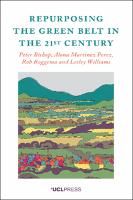Repurposing the Green Belt in the 21st Century
Author(s)
Bishop, Peter
Perez Martinez, Alona
Rogemma, Rob
Williams, Lesley
Language
EnglishAbstract
The green belt has been one of the UK’s most consistent and successful planning policies. Over the past century, it has limited urban sprawl and preserved the countryside around our cities, but is it still fit for purpose in a world of unprecedented urban growth and potentially catastrophic climate change? Repurposing the Green Belt in the 21st Century examines the history of the green belt in the UK and how it has influenced planning regimes in other countries. Despite its undoubted achievements, it is time to review the green belt as an instrument of urban planning and landscape design. The problem of the ecological impact of cities and the mitigation measures of major climate changes are at the top of the urban agenda across the world. Urban agriculture, blue and green infrastructures, and forestation are the new ecological design imperatives driving urban policymaking. Through an examination of practice in the UK and in countries such as the Netherlands, Spain and Germany, the book proposes a framework for a reconsideration of the critical relationship between the city and its hinterlands for the 21st century. It will be useful for undergraduate and postgraduate students of planning, landscape architecture, urban design, architecture and land economics, as well as practitioners in design, planning and property/real estate.
Keywords
green belt; planning; architecture,built environment; urban studies; urban sprawl; landscape design; green infrastructureDOI
10.14324/111.9781787358843ISBN
9781787358843, 9781787358850, 9781787358867, 9781787358874, 9781787358881, 9781787358843Publisher
UCL PressPublisher website
https://www.uclpress.co.uk/Publication date and place
London, 2020Imprint
UCL PressClassification
City and town planning: architectural aspects


 Download
Download